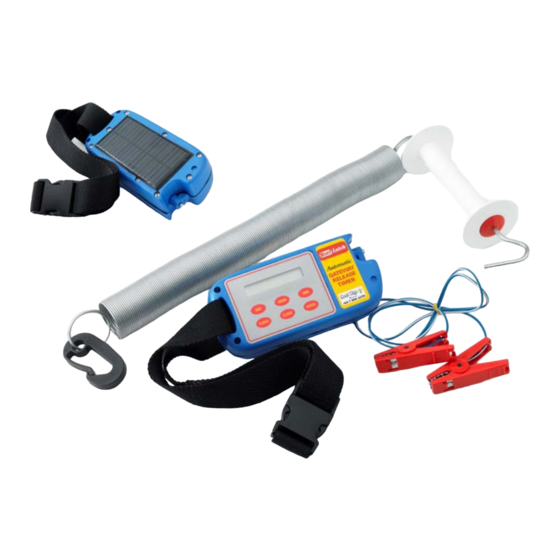Table of Contents
Advertisement
Advertisement
Table of Contents

Summary of Contents for Novel Ways Batt-Latch
- Page 1 Automatic Gateway Release Timer Instruction Manual ► Revised April 2009...
-
Page 2: Table Of Contents
Novel Ways Limited. While every effort has been made to ensure the accuracy of the information in this manual, Novel Ways Limited accepts no responsibility for any errors or their consequences. The contents of this manual are subject to change without notice. -
Page 3: Features And Overview
1 Features and Overview The Batt-Latch is a portable timer which waits until a preset time and week day, then mechanically releases an attached spring/bungy/tape gate using its internal gearbox. It can be incorporated into normal farming practice by swinging standard or any other types of gates open and temporarily replacing them with the Batt-Latch release unit, and a spring or tape gate. - Page 4 Visits to the run-off can be made less frequently by using the Batt-Latch. The Batt-Latch(es) can be set up so that they are releasing 2 or 3 days apart and letting stock into a fresh new grazing area. This method can reduce run-off visits to only once in 10 days.
-
Page 5: Operating Instructions
Switching ON Press any of the keys on the Batt-Latch, and it will switch on and display the current day and time. The Batt-Latch automatically switches itself off again after 45 seconds of inactivity (no button presses). Remember to check that the current day and time are set correctly - if they are not correct, refer to the section 2.3 Setting the Time. -
Page 6: Setting The Time And Weekday
Press ENTER to confirm your answer. Step 6. The JOB is set. The Batt-Latch will now do a gate release at the set time. To set another JOB repeat steps 2 – 5. A maximum of four JOBs can be stored. -
Page 7: Clearing A Job
[GOING TO SLEEP..] The internal clock will still be running and the Batt-Latch is always checking if it has to perform a JOB. When the time comes to perform a JOB the Batt- Latch will wake up and perform a gate release. -
Page 8: Charging The Unit
In normal use outdoors, this will not occur, as the sun will provide plenty of free energy. If the Batt-Latch has been stored or is used in deep shade, it is advisable to recharge the Batt-Latch the first time that you see the warning sign, as this will prevent any possible release failure due to the battery being in a very low state of charge. -
Page 9: Using The Batt-Latch
Latch, and changes in the suggested procedure may have to be made to suit your own needs. The Batt-Latch can be used on any farm. All that needs to be done is to open the standard gates (wood, pipe or any other type) so that they are out of the way and temporarily fit a spring/tape gate to one side of the gateway. -
Page 10: Useful Hints From Users
Once-a-day summer milking: By milking in the morning and utilising a Batt-Latch to free the herd to new pasture in the afternoon, there is no need for workers to come back onto the farm just for that job, saving labour and freeing up leisure time. - Page 11 Preventing new pasture pugging: Some dairy farmers save major pugging damage to new and susceptible pasture by blocking the gateway to that paddock with a Batt-Latch until all the herd has arrived from milking. About 10 minutes later the gate is released and the herd enters quietly and together with no human intrusion, reducing impact on the sward, particularly in the gateway.
- Page 12 Batt-Latch in the early hours, but running out of feed before milking starts, and deciding to return to the paddock! One of our customers suggests this technique: stretch a bungy cord across the front of the feedpad (or down the race a bit).
- Page 13 So now you can control any stock movements with the Batt-Latch system – unattended, or from a range of 5km by remote if needed. A lower cost portable remote can be used from a nearby vehicle.
-
Page 14: Safety Information And Trouble-Shooting
The Batt-Latch has many applications, each posing its own potential safety issues. For example, when using as a spring gate release, the Batt-Latch will display and sound a warning before it releases the gate. However, extra care should be taken when children are around. - Page 15 Call Novel Ways for information or advice Freephone (NZ) 0800-003-003 +64 7 856 6270 Or return the unit to Novel Ways for speedy repair. Novel Ways, 436 Morrinsville Rd, RD4 HAMILTON 3284 N.Z. Batt-Latch Instruction Manual...
-
Page 16: Technical Specifications
Case: Polycarbonate composite, waterproofed with neoprene sealing gasket and O-rings, underwater tested. For your records Batt-Latch Purchase Date: Purchased from: Serial Number: 12 Month Warranty from purchase date. 436 Morrinsville Road RD 4 Hamilton 3284 New Zealand www.novel.co.nz phone 64 7 856 6270 fax 64 7 856 6439...

Need help?
Do you have a question about the Batt-Latch and is the answer not in the manual?
Questions and answers